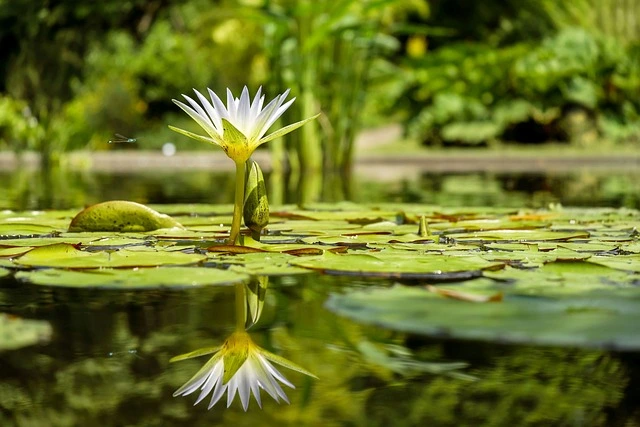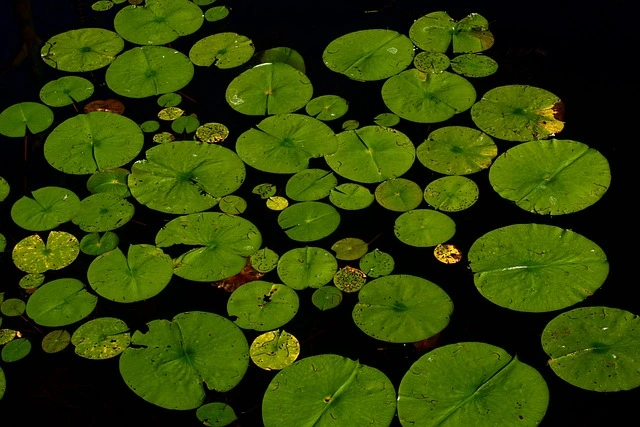Water lilies play a crucial ecological role by contributing to water quality by absorbing excess nutrients and providing shade and shelter for aquatic organisms. In addition to appreciating the beauty of water bodies, besides these, the water lily has long symbolized purity, beauty, and the enlightenment of many cultures as an ornamental plant. Moreover, their graceful beauty inspires nature lovers, artists, and poets.
This page explores the mesmerizing allure of water lily flowers, delving into their history, symbolism, types, anatomy, life cycle, adaptations, and more. Let’s dive into the fascinating world of these exquisite aquatic blooms.

Read: Tiger Lily: Care, Significance, and Medicinal Uses Unveiled!
Graceful Beauty of Water Lily Flowers
Water lilies, a delicate flower, belong to the family Nymphaeaceae and are known for their unique adaptations to aquatic environments.
Lilies have wide (broad), round-shaped leaves that provide buoyancy in water bodies (ponds, slow-moving streams, and lakes). Moreover, their roots support muddy or sandy bottoms, ensuring stability and nutrient availability.
A water lily’s beautiful flowers flourish on a long stalk called a peduncle, which rises above the water. However, it is famous for its vibrant colors, including white, pink, red, blue, and yellow. Looking at the flowers during the day and at night is attractive because they are open and closed.
However, the silent features are:
| Feature | Description |
| Scientific Name | Nymphaeaceae |
| Common Name | Water Lily |
| Sun Exposure | Full sun to partial shade |
| Water Type | Freshwater ponds, lakes, slow-moving streams |
| pH Range | 6.0 – 7.5 |
| Height | Varies, typically 1 – 2 feet (30 – 60 cm) |
| Bloom Period | Spring to late summer |
| Leaf Shape | wide (Broad), round-shaped leaves |
| Leaf Position | Float on the water’s surface |
| Root System | support in muddy or sandy bottoms beneath leaves |
| Flower Colors | White, pink, red, blue, yellow, and more |
| Flowering Time | Daytime blooming, closing at night |
| Ecological role | Provides shade and shelter for aquatic organisms |
| Nutrient absorption | It helps maintain water quality by absorbing excess nutrients, so highly nutritional. |
Read: Lilium Candidum (Madonna Lily) – Propagation, Care, and Diseases
The symbolism of water lilies
There has been a strong connection between water lilies and various Asian cultures since ancient Egyptian civilizations. They were often illustrated in tomb paintings and hieroglyphics in ancient Egypt as symbols of rebirth and the afterlife. Moreover, water lilies also hold deep spiritual symbolism in Buddhism and Hinduism, symbolizing purity, enlightenment, and the cycle of life.

Various classes of water lilies
There are numerous types and varieties of water lilies, each displaying unique characteristics. However, water lilies come in various classes and varieties, each with a special charm. Some popular types include;
- hardy water lilies suitable for multiple climates,
- tropical water lilies known for their vibrant colors, and night-blooming water lilies (Botanic name: Nymphaea spp.) that open after sunset.
The varieties of water lilies come in various colors and sizes that attract anybody to encourage them to take the initiative towards water gardens.
Salient Features of Water Lilies
To truly appreciate the beauty of water lilies, it is essential to explore their salient features. These flowers have lily pads that float on the water’s surface, providing a platform for the blooms to rise above. However, the flowers contain several delicate petals and a central receptacle, which houses reproductive organs.
A water lily’s beautiful flowers flourish on a long stalk called a peduncle, which rises above the water. One of the most salient features of water lilies is their ability to close their flowers at night and reopen them in the morning, a phenomenon known as nyctinasty.
Additional features include:
- Additionally, water lilies have a unique pollination mechanism. Instead of relying on bees or insects, they rely on beetles to transfer pollen from one flower to another.
- Another fascinating fact is that water lilies can grow in water up to 30 – 60 cm (~ 6 – 24 inches), adapting their growth pattern to available sunlight and water conditions.
The propagation of water lilies.
The life cycle of a water lily is a fascinating process that showcases the durability and adaptability of these unique plants. However, Its propagation cycle goes as follows:
- Initially, seeds germinate underwater, evolving into young plants with lily pads.
- A lily pad is supported at a depth of water by long stems called petioles, which produce more leaves as the plant matures.
- The plant sends out a flower bud when it is ready to bloom that gradually unfolds into an astounding waterlily.
Therefore, the propagational hierarchy goes in this manner:
Seeds → lily puds → petioles → flower buds → water lily
Few propagational methods to grow water lily
Water lily can propagate through various methods, offering indoor and outdoor gardeners options to expand their collections and add an attractive look to gardens and interiors.
| Propagation Method | Steps involved |
| Seeds | Water lilies produce seeds after flowering. Seeds can be collected and germinated in a controlled environment before planting under suitable aquatic conditions. |
| Tubers | Mature water lilies come from tubers or rhizomes. These can be divided during the winter, ensuring each section has buds or eyes. Furthermore, the divided tubers are then planted to grow into new plants. |
| Cuttings | Root cuttings can be taken from healthy plants and placed in a rooting medium. Upon successful rate of root development, the cuttings can be planted in water gardens or ponds. |
Water Lily Adaptations
Water lilies have evolved adaptations that enable them to survive and grow in their aquatic environment. One of their most notable adaptations is their ability to stay on water. Water lilies have wide (broad), flat leaves that maintain momentum on the surface of the water. However, they have air chambers that provide buoyancy, an extensive root system that anchors them to the muddy or sandy bottom of water bodies, night blooms, a hydrophobic coating, and vivipary.
Subcategory of Water Lily Adaptations
Leaves adaptive nature
As they float on the water’s surface, water lilies are able to absorb a huge amount of light through their flat leaves.
Vegetative propagation
Water lilies have rhizomes, horizontal, underground stems that grow laterally. By spreading and establishing new plants, the rhizomes produce new plants through vegetative propagation. However, water lilies have long, flexible stems that enable them to adjust their position according to the water’s depth.
Air chambers
The leaves and stems have air chambers that provide buoyancy, keeping the plant afloat. Moreover, their lily pads have air-filled spaces, providing buoyancy and preventing them from sinking.
Root System
Their extensive root system anchors them to muddy or sandy water bottoms, ensuring stability and nutrient absorption.
Night blooms
Some species have flowers that open at night, attracting nocturnal pollinators like moths.
Hydrophobic coating
The leaves have a waxy, hydrophobic coating that repels water, keeping them dry and preventing waterlogging.
Vivipary
Some species produce plantlets on the edges of their leaves, allowing them to propagate vegetatively before detaching and forming new plants.
Long stalks
The flowers rise above the water on long stalks (peduncles) to attract pollinators and improve their chances of successful reproduction in water habitats.

A water lily vs. a Lotus
Water lily and lotus flowers are often confused due to their similar appearances. While they may share certain resemblances, they belong to different plant families. Water lilies belong to the Nymphaeaceae family, while lotus flowers belong to the Nelumbonaceae family[1]Study about graceful beauty of Lotus flower. Read.
However, the way their flowers and leaves are shaped is a significant difference between the two. Water lilies have floating leaves and flowers, whereas lotus flowers have leaves that rise above the water on long stalks.

Monitoring checklist for Water Lily Flowers
It is essential to know the particular requirements of water lily flowers in order to care for them correctly. Meanwhile, first and foremost, they require
- A perfect aquatic environment, with proper sun exposure from full sun to partial shade and still water.
- Adequate fertilization is crucial for their growth, as water lilies are highly nutrient absorbers.
- Regular removal of dead leaves and flowers helps maintain the health and development of the plants.
- Protecting plants from extreme temperatures and pests is essential for their entire well-being.
Read: Ginger Lily Plant Propagation, Diseases, and Care
Water Lilies Place in Art
Water lilies have long inspired artists and writers, finding their place in various artistic and literary works throughout history. One of the most notable examples is their collection of water lily paintings by Monet, a renowned artist. However, water Lilies, for example, is a peaceful representation of the beauty of these flowers and their reflection in the water. Water lily has also been featured in poems, novels, and other forms of artistic expression, symbolizing beauty, peace, and calm themes.

Summing up it all
To cut a long story short, water lilies are an excellent example of nature’s ability to adapt to aquatic environments. Ponds and lakes are more attractive and ecologically balanced with floating leaves, buoyant stems, and extensive roots. However, their history, symbolism, types, anatomy, and adaptations contribute to their fascinating world. In addition, nature’s beauty best appreciates through these enchanting aquatic wonders that remind us that nature is resilient.



